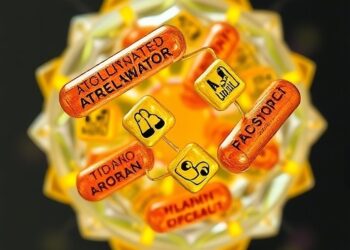Bioengineering has reached a remarkable milestone with the groundbreaking research led by Rashid Bashir, a prominent professor and the Dean of The Grainger College of Engineering. This innovative research is centered around a novel CRISPR-based diagnostic technology designed to rapidly and sensitively detect multi-drug-resistant bacteria and various other pathogens, even at low concentrations. As the global threat posed by antibiotic-resistant infections continues to escalate, the need for rapid and reliable diagnostic methods has never been more pressing. This pioneering work holds the potential to revolutionize how we approach infection detection and management in clinical settings.
At the core of this research lies a unique CRISPR-based test that effectively identifies low levels of pathogen genetic material present in blood samples. Unlike traditional methods that rely on nucleic acid amplification, which can be time-consuming, this new approach promises swift results, ushering in a new era of diagnostic efficiency. The implications of such a test are far-reaching, particularly in areas where timely intervention is crucial, such as sepsis, a life-threatening condition that arises when the body responds poorly to an infection.
CRISPR, or Clustered Regularly Interspaced Short Palindromic Repeats, has already disrupted various fields, from genetics to agriculture. Researchers have harnessed this powerful technology to create diagnostic tools that can identify specific DNA or RNA sequences associated with pathogens. In standard CRISPR/Cas-based diagnostic tests, guide RNAs are designed to bind to the targeted pathogen’s genetic material, prompting Cas enzymes to cleave reporter nucleic acids. This process creates a fluorescent signal that indicates the presence of the pathogen. However, conventional single CRISPR techniques struggle to detect low-level infections without a time-consuming amplification step, which can hinder the speed of diagnosis.
Bashir’s team circumvented this limitation by ingeniously combining two CRISPR/Cas units into a complex known as CRISPR-Cascade. This innovative configuration leverages a system where one unit contains a guide RNA tailored to a specific pathogen’s genetic material, along with an associated Cas protein. When the Cas enzyme cleaves specially engineered nucleic acids integrated into the assay, it results in the liberation of parts of those nucleic acids. This offers the opportunity for them to bind and activate a second CRISPR/Cas unit. The interplay between the first and second CRISPR units generates a positive feedback loop, amplifying the signal and substantially improving the test’s sensitivity.
This new testing mechanism has showcased extraordinary capabilities, achieving unprecedented sensitivity levels. The team successfully demonstrated its ability to detect the DNA of multi-drug-resistant Staphylococcus aureus—commonly known as MRSA—at concentrations orders of magnitude lower than those detectable by traditional single Cas methods. Moreover, the system has proven capable of instantly providing a clear “yes/no” result concerning the presence of various pathogens, even within samples spiked with four common bloodstream pathogens. This amalgamation of high accuracy and rapid response time could profoundly enhance clinical decision-making processes.
The research team’s findings were recently highlighted in the highly-regarded Proceedings of the National Academy of Sciences of the United States of America (PNAS), underscoring the significance of their work within the scientific community. Such recognition is critical, as it propels the research further into the spotlight, potentially attracting the interest of both investors and healthcare practitioners. The detailed account of the research elucidates how this amplification-free detection system could be adapted for routine clinical use.
The implications of this research extend beyond mere scientific curiosity; they offer a potential paradigm shift in how healthcare systems can approach the diagnosis of infections. The traditional methods often face delays in diagnosis that can lead to dire consequences for patients, especially those with compromised immune systems. With this new CRISPR-Cascade technology, clinicians may soon find themselves equipped with tools capable of delivering results in a fraction of the time, facilitating timely and effective treatment strategies.
As antibiotic resistance continues to threaten public health, the need for innovative diagnostic solutions has never been more urgent. This research not only emphasizes a technological leap forward but also reflects the pressing need for the scientific community to focus on practical applications of their discoveries in medicine. The combination of speed and sensitivity presented by Bashir’s research holds the promise of making a substantial impact in combating resistant pathogens and improving health outcomes.
The road ahead involves further refinement of the CRISPR-Cascade technology to broaden its applicability across a wider range of pathogens. Research efforts will need to focus on increasing the versatility of the guide RNAs and optimizing the overall system for use in diverse clinical environments. This next stage of development will be crucial in determining its viability in real-world clinical scenarios, paving the way for the commercial availability of these tests.
In conclusion, the groundbreaking work led by Rashid Bashir and his team represents a remarkable advancement in bioengineering and diagnostic technology. The ability to detect pathogens at low concentrations without requiring nucleic acid amplification could fundamentally alter the landscape of infectious disease management. As the research progresses towards practical implementation, the hope is that this technology will not only enhance our ability to diagnose challenging infections promptly but will also contribute to a larger strategy to overcome the burgeoning crisis of antibiotic resistance threatening global health.
Subject of Research: CRISPR-based diagnostic technology for detecting multi-drug-resistant bacteria
Article Title: Amplification-free, OR-gated CRISPR-Cascade reaction for pathogen detection in blood samples
News Publication Date: 10-Mar-2025
Web References: DOI
References: Not provided
Image Credits: Not provided




